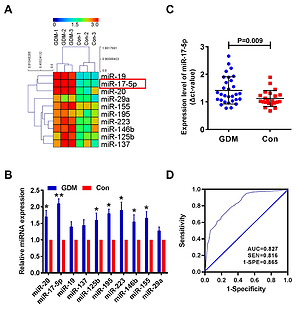Current issue
Archive
Manuscripts accepted
About the Journal
Editorial office
Editorial board
Section Editors
Abstracting and indexing
Subscription
Contact
Ethical standards and procedures
Most read articles
Instructions for authors
Article Processing Charge (APC)
Regulations of paying article processing charge (APC)
DIABETOLOGY / RESEARCH PAPER
MicroRNA-17-5p acts as a biomarker and regulates mitochondrial dynamics in trophoblasts and endothelial cells by targeting the mitofusins Mfn1/Mfn2 in gestational diabetes mellitus
1
Department of Obstetrics and Gynecology, Tangshan Gongren Hospital, China
2
Department of Internal Medicine, Tangshan Gongren Hospital, China
3
Department of Cardiology, Tangshan Gongren Hospital, China
4
Department of Endocrinology,Tangshan Gongren Hospital, China
Submission date: 2021-05-24
Final revision date: 2021-12-24
Acceptance date: 2022-01-12
Online publication date: 2022-01-21
KEYWORDS
TOPICS
ABSTRACT
Introduction:
Gestational diabetes mellitus (GDM) is a metabolic disease that endangers pregnant women and their offspring. Insights into biomarkers and GDM pathogenesis are crucial. Ectopic expression of microRNA-17-5p was found in GDM, but its the diagnostic value and role of miR-17-5p remain unclear.
Material and methods:
Detection of miRNA microarray and quantitative PCR (qPCR) found that miR-17-5p was significantly increased and positively associated with biochemical indicators of GDM in 30 GDM plasma samples and 28 matched control plasma samples.
Results:
The area under the ROC curve was 0.827 (P < 0.01), which showed good diagnostic potential. Mitochondrial staining showed that compared with controls, trophoblasts exhibited more mitochondrial fusion and endothelial cells exhibited more mitochondrial fission in GDM than these in controls. Western blot and qPCR assays further revealed that expression of the mitofusin Mfn1/Mfn2 was lower in primary endothelial cells from GDM patients, whereas their expression was significantly higher in primary trophoblasts from GDM patients compared with those from controls. Conversely, miR-17-5p expression was higher in primary endothelial cells from GDM patients, whereas their expression was significantly lower in primary trophoblasts from GDM patients compared with those from controls. Bioinformatics and luciferase reporter assays confirmed that both Mfn1 and Mfn2 are targets of miR-17-5p. Last, decreased Mfn1/2 was observed not only to increase the apoptotic rate of primary endothelial cells from GDM, but also to reverse anti-apoptotic effects of miR-17-5p inhibitor.
Conclusions:
MiR-17-5p regulates Mfn1/Mfn2-mediated mitochondrial dynamics involved in GDM. MiR-17-5p may serve as a promising biomarker and therapeutic target for GDM.
Gestational diabetes mellitus (GDM) is a metabolic disease that endangers pregnant women and their offspring. Insights into biomarkers and GDM pathogenesis are crucial. Ectopic expression of microRNA-17-5p was found in GDM, but its the diagnostic value and role of miR-17-5p remain unclear.
Material and methods:
Detection of miRNA microarray and quantitative PCR (qPCR) found that miR-17-5p was significantly increased and positively associated with biochemical indicators of GDM in 30 GDM plasma samples and 28 matched control plasma samples.
Results:
The area under the ROC curve was 0.827 (P < 0.01), which showed good diagnostic potential. Mitochondrial staining showed that compared with controls, trophoblasts exhibited more mitochondrial fusion and endothelial cells exhibited more mitochondrial fission in GDM than these in controls. Western blot and qPCR assays further revealed that expression of the mitofusin Mfn1/Mfn2 was lower in primary endothelial cells from GDM patients, whereas their expression was significantly higher in primary trophoblasts from GDM patients compared with those from controls. Conversely, miR-17-5p expression was higher in primary endothelial cells from GDM patients, whereas their expression was significantly lower in primary trophoblasts from GDM patients compared with those from controls. Bioinformatics and luciferase reporter assays confirmed that both Mfn1 and Mfn2 are targets of miR-17-5p. Last, decreased Mfn1/2 was observed not only to increase the apoptotic rate of primary endothelial cells from GDM, but also to reverse anti-apoptotic effects of miR-17-5p inhibitor.
Conclusions:
MiR-17-5p regulates Mfn1/Mfn2-mediated mitochondrial dynamics involved in GDM. MiR-17-5p may serve as a promising biomarker and therapeutic target for GDM.
We process personal data collected when visiting the website. The function of obtaining information about users and their behavior is carried out by voluntarily entered information in forms and saving cookies in end devices. Data, including cookies, are used to provide services, improve the user experience and to analyze the traffic in accordance with the Privacy policy. Data are also collected and processed by Google Analytics tool (more).
You can change cookies settings in your browser. Restricted use of cookies in the browser configuration may affect some functionalities of the website.
You can change cookies settings in your browser. Restricted use of cookies in the browser configuration may affect some functionalities of the website.



